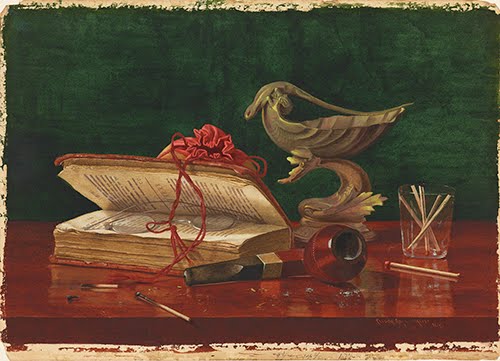Claude Raguet Hirst Realism
Nothing showcases the American obsession with realism in art during the 1800s better than the brief Trompe l’Oeil Realism movement of the 1880s and 1890s. Like the Dutch Baroque realist still-life genre of the 1600s, American Trompe l’Oeil (literally “deceive the eye” in French) was popular with middle class art patrons because it was clever and it displayed a sophisticated technique.
Yeah, we know all great artists in history are total realists, right? My point in pointing out this movement is that art history texts on American art highlight very few of the numerous American artists working in the style, most notably women.
 |
| Claude Raguet Hirst (1855–1942, US), Book Closed Over Spectacles, ca. 1894. Watercolor on illustration board, board: 10 7/8" x 15" (27.6 x 38.1 cm). © 2018 Philadelphia Museum of Art. (PMA-8307) |
The trompe l’oeil phenomenon did not suddenly start in the 1880s, although many art history texts treat it that way. During the earliest decades of the 1800s, American artists, including women in the Peale family—an American art dynasty led by Charles Willson Peale (1741–1827)—painted trompe l’oeil still lifes that were influenced by the Dutch Baroque. In the mid-1800s, many women genre artists such as Lilly Martin Spencer (1822–1902) were renowned for their ability to realistically depict the texture of still-life objects. As far as I’m concerned, I think American art history books should mention more than William Harnett (1848–1892), John Peto (1854–1907), and John Haberle (1856–1933). They should also feature Claude Hirst (1855–1942), born Claudine.
Hirst starting signing her paintings “Claude” in the 1870s because it was obviously easier for male artists to sell paintings at the time. The trompe l’oeil genre was popular among patrons rather than art critics, who considered such work technical proficiency rather than aesthetic. They were more likely to be found in bar rooms (the domain of men) than in gallery auctions. This would explain why so much of the imagery in these still-life paintings is predominantly male-oriented. Both of the paintings shown here have the trappings of a scholar, obviously male, with images of a pipe. Toward the late 1890s, Hirst began to include books with open pages from texts that spoke of experiences of late-1800s women. In works such as Companions, she also includes examples of art pottery, a field dominated by women. In both examples, her brilliant mastery of watercolor—known in the 1800s as a “lady’s medium”—imitates the smooth, highly detailed surfaces of oil painting.
.jpg) |
| Claude Raguet Hirst (1855–1942, US), Companions, 1895. Watercolor on board, 10" x 14 1/2" (25.4 x 36.8 cm). © 2018 Butler Institute of American Art, Youngstown, OH. (BIAA-526) |
Hirst was born in Cincinnati and first studied art at the School of Drawing and Painting at the University of Cincinnati. She moved to New York in 1879 and studied privately, building her reputation as a skillful still-life painter of flower and fruit subjects. She ultimately became a masterful watercolorist, as is obvious in both of these works.
In the 1890s, when the trompe l’oeil style became really popular, Hirst began to branch out into still life of objects related to male pastimes. By 1895, she was incorporating small nods to women in the arts. The antique books she featured by the end of the 1890s (antique book collecting was a fashion among the “elite”) often featured text that was legible. This was quite a feat using watercolor!
In the 1910s, well into her 60s, Hirst eliminated the references to male pastimes in favor of her earlier floral and fruit works. By that time, she began to receive prizes from juried exhibitions and received critical acclaim for her work during a period when Impressionism and the Ash Can School were also prominent. She painted into her 80s, producing more than 100 still-life works.
Correlations to Davis programs: Explorations in Art 1E Grade 5: 2.7; Explorations in Art 2E Grade 5: 2.1; The Visual Experience: 9.9


Comments